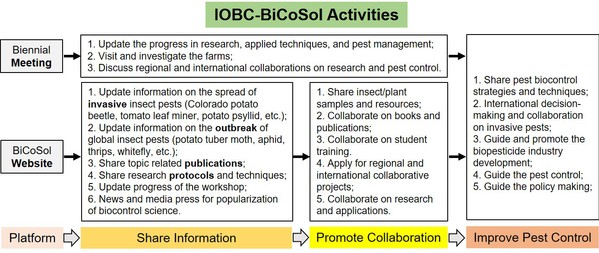About IOBC-BiCoSol
1. Description
The solanaceous crops are major economic and agricultural crops worldwide. The estimated annual global cultivation for potato, tomato, eggplant, and chillies/peppers are 17, 4.7, 1.8, and 1.9 million hectares, producing 368, 182, 54, and 36 million tons of products, respectively (FAOSTAT 2018). These crops are attacked not only by the already globally distributed pests including the potato tuber moth (Phthorimaea operculella, PTM), aphids, leaf miners, thrips (western flower thrips), and whitefly (Bemisia tabaci), but also by the rapid spread of invasive species including the Colorado potato beetle (Leptinotarsa decemlineata, CPB), the tomato leaf miner (Tuta absoluta), and the potato psyllid (Bactericera cockerelli). Quick exchange of newly developed information on biological control of these pests and research collaboration in the field of finding, evaluating and developing practical biological control methods could help in solving these worldwide pest problems.
Stock taking of natural enemies of the insect pests in potato and other solanaceous crops, including predators and parasitoids, has been made during the past century and some natural enemies have been widely studied. However, the application of biological control to suppress solanaceous pests is limited to specific geographic regions. For instance, in the control of CPB, egg parasitoids and predators were mainly applied in North America (USA, Canada, etc.), whereas the natural enemies that were introduced into Europe failed in Europe. For the management of PTM, parasitoids for eggs and larvae were successfully established in countries of southern Africa, Australia, New Zealand, and India. In many regions, however, PTM biocontrol is poorly understood, as are the biological control possibilities for other insect pests of solanaceous crops. At this moment, the following pests are particularly problematic: Bactericera cockerelli, Tuta absoluta, Leptinotarsa decemlineata (Olaniyan et al., 2020; McNitt et al., 2020; Cohen et al., 2020). To promote the success of biological control for solanaceous pests, an integrative approach including identifying the locally adapted species, providing a favorable agroecosystem (e.g.flower strips), and integration of biological control with other technologies (biopesticides, cultural controls, crop resistance, etc.), is needed. Thus, a global working group IOBC-BiCoSol would help clarifying the current obstacles in control of solanaceous pests and speed up the development of biological control.
2. Aims of the working group
Establishing an international platform for scientists working on biological control and ecological management of solanaceous pests for the field crops;
Promoting knowledge exchange, joint project building, and research collaboration between scientists;
Promoting the application biological control strategies in the management of solanaceous pests worldwide.
3. Activities

IOBC-BiCoSol convenors build two platforms for information exchange between the group members: a website based in IOBC and the biennial meeting hosted by group members in different regions and countries.
In the website, information related to the IOBC-BiCoSol, including the pest problems (spreading of invasive pests, the outbreak and damage of global pests, and the distribution of natural enemies) and the advances of studies and techniques, will be updated and shared by the group members intensively, and then released to the general public (scientist, farmers) through the press and media.
The biennial meeting will be carried out in different regions with solanaceous crops playing important roles in their economy. In the meeting, the progress of research and application will be shared, and the scientists will visit the farms for solanaceous crops to meet the ‘real pest problems’.
The collaborations between group members will be promoted in the form of publications and joint projects.